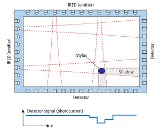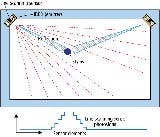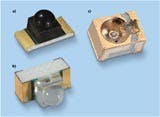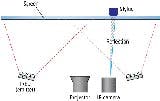Optical touchscreens benefit from compact, high-power infrared LEDs (MAGAZINE)
+++++
This article was published in the September 2013 issue of LEDs Magazine.
Visit the Table of Contents and view the E-zine version in your browser. You can download a PDF of the magazine from within the browser E-zine.
+++++
You can swipe, you can press, you can pinch, and you can expand — touchscreens are the input media of the future. Users appreciate the fact that they are so convenient and easy to use. And industry is making increasing use of intuitive and robust touchscreens for various devices and controllers. From the small display on a smartphone to huge screens suitable for several people to operate, there are many different technologies involved in this wide range of products. Up until now, optical-based touch-sensing solutions have been preferred for large displays. With the development of high-efficiency infrared (IR) LEDs (sometimes called IREDs), this technology has become attractive even for small touch panels, such as those on notebooks and tablets (Fig. 1).
The launch of Windows 8 in October 2012 gave the already popular touchscreens a further boost. The operating system has been designed specifically for this type of input and is a driving force behind the development of suitably equipped all-in-one computers and notebooks. Initial feedback from users indicates that they appreciate being able to use fully featured computer programs by touching the screen, particularly when working with photos and graphics.
There are different ways in which the position of a finger or stylus on the screen can be detected. Resistive displays have traditionally been used. Such displays are equipped with two conductive films separated by an air gap and coated on a glass display. Pressing down with your finger closes the gap between the two layers of film, allowing current to flow. Electrical resistance is then used to calculate the point of contact. Capacitive solutions are also widespread. These produce an electrical field in a special surface layer. Contact between this layer and a conductive object, such as a finger, causes a change in the electrical field. Optical touchscreens may be realized by creating a light grid over the display using IR LEDs, in which an object touching the display either casts a shadow or causes light to be reflected, depending on the design (Fig. 2 and 3).
Optical touchscreens
Optical solutions are now on the march, particularly for large displays. Their benefit lies in the excellent image quality because they do not need any special coatings that absorb a certain percentage of the backlighting. They can detect any type of pointer or stylus and even fingers in gloves because they are not reliant on the conductivity of these objects. Optical designs are also not at all sensitive to scratches and, depending on the power of the emitters, can be used for any size of screen. In most cases the optical components are mounted in a frame around the display, so this technology can be used to upgrade existing displays without major difficulty. Optical touchscreens used to be considered too expensive, too large, and too sensitive to ambient light. New, compact, and powerful IR LEDs now provide the basis for cost-effective, low-profile touchscreens, thereby countering the first two of these arguments. The third point, namely the sensitivity to ambient light, can be overcome by appropriate display design techniques that we will cover.
The commonly used technologies for optical touchscreens are presented here. They all benefit from highly efficient thin-film chip technology, which provides the basis for compact IR LEDs with high optical output. There is a wide range of packages for all design options — from narrow-angle emitters for light grids to high-power emitters for illuminating large displays (Fig. 4). With a wavelength of 850 nm, IR LEDs perfectly meet the requirements for touchscreens. Their light is barely visible to the naked eye but is easily registered by the detectors. For exceptional cases in which the residual visible light from the 850-nm emitter is unwelcome, there are 940-nm chips available.
Light grids
The simplest solution for optical touchscreens is a light grid created by rows of infrared emitters and detectors placed opposite one another (Fig. 2). The components are mounted in a low-profile frame around the screen, just a few millimeters deep, known as a bezel. A finger or stylus blocks the light beams, causing the detector signal to attenuate at the appropriate point. This design can be used as a multi-touch version, if the emitters and detectors are switched sequentially and the signals are evaluated appropriately.
Important factors for selecting an emitter are the size of the component, its optical output, and its radiant intensity — in other words, the distribution of the light. High radiant intensity is synonymous with an intense narrow-angle beam. High radiant intensities enable large screen diagonals to be covered. Narrow beam angles, coupled with narrow detection angles on the detectors, ensure that even on large displays the beams from the individual emitters do not hit more than one sensor.
Ideal for grid applications are IR LEDs and phototransistors in low-profile packages with an angle of ±15° such as Osram's 1.6-mm-high Midled family, allowing bezel depths of around 2.3 mm. Chipled products enable bezel depths less than 2 mm. In some applications, particularly ones where there is strong halogen lighting, it is advisable to use daylight filters to reduce the influence of ambient light on the detectors (Fig. 4).
The design of such a light grid can be easily scaled up to larger screen diagonals. Compared with non-optical technologies, this scaling involves less expense because the functional components are mounted in the frame around the display. The scaling factor in the case of optical touchscreens is dependent on the circumference; in all other technologies the scaling factor is dependent on the square of the display. However, remember that light output reduces in proportion to the square of the distance from the detector. This in turn leads to a poorer signal-to-noise ratio for the touch signal and it may be necessary to adjust the emitter current accordingly. Size requirements can thereby impact both component selection and the driver circuit.
Light from the corners
An optical design with line-scanning optical sensors, essentially cameras, needs far fewer components than the light-grid version. In this setup, high-power IR LEDs are used to flood the display with infrared light from two corners (Fig. 3). There are also detectors — optically separated to prevent crosstalk — that only receive a signal when objects on the display reflect the infrared beams. In most cases, the sensors are line scanners, such as those used for barcode readers or flat-bed scanners. The precise position and size of the finger or stylus are calculated by evaluating both signals using a procedure similar to triangulation.
Depending on the resolution of the sensor, the corner-based design has the potential to produce touchscreens with a much higher resolution than with other technologies. This design is also particularly attractive because it can be scaled up to larger screens without the need for additional components, as long as you make sure that the emitters produce enough light. Displays with a screen diagonal of 12 inches and larger are mainly being used at present.
In a slightly modified version, light guides are mounted around the display and are fed with light by IR LEDs at the corners. Light exits the light guide at certain intervals along its length, creating a curtain of light over the display. The line sensors register the shadows that are cast by objects on the display.
Both approaches require IR LEDs with sufficient optical output to illuminate the entire screen. However, they must be small enough for low-profile displays. The latest development for this area of application is the Chipled SFH 4053. Measuring only 0.5×1×0.45 mm, it is one of the slimmest components of its output class (shown in Fig. 1). With an 8-mil chip in thin-film technology, this IR LED produces 40 mW at 70 mA, and up to 260 mW at 700 mA in pulse mode. That output level can easily illuminate a notebook screen.
While IR LEDs with a wide beam angle are suitable for illuminating from the corners, the choice of emitters for the light guide version depends on the design of the light guide. Midled types, which have a narrow beam angle and a flat surface, are ideal for injecting light into light guides. Osram has published an application note that provides more information on the design of the light guide solution. One approach that is covered frees the touch signal from ambient light influences by first measuring the light level without infrared illumination and then measuring with infrared illumination and calculating the difference between the two signals.
Projection for large displays
Large projection panels present another set of challenges yet can be implemented with optical touchscreen technology. A system can project the infrared light from the rear just as the image is projected from the rear. A finger or stylus on the display reflects the light to one or more IR cameras (Fig. 5).
Such a projection design does emit infrared light on the surface. If the display is recorded by cameras — for example, in a TV studio — the light can interfere with the camera signal. One possible solution is to use 940-nm emitters. Alternatively, a design in which the infrared light is injected into the glass plane of the display can be used (Fig. 6). The IR LEDs, for instance, emit light into the glass so the beams are totally reflected at the top and bottom surfaces. Only when an object touches the surface can the light escape and be scattered, allowing the detectors to capture the change. The technique is known as frustrated total internal reflection (FTIR).
These two versions of optical touchscreens do not require a bezel and therefore give designers greater flexibility. Projection solutions generally need IR LEDs with extremely high output, such as the Dragon, Oslon, or Ostar LEDs from Osram. In FTIR systems, the design must ensure a high number of internal reflections. The application note describes the relevant requirements and lists appropriate emitters. Depending on the setup, suitable components may, for example, be narrow-angle Midleds that achieve very high optical output, or Oslon IR LEDs, currently the smallest IR LEDs in the 1W class.
In-cell sensors
In-cell technology is a relatively new development. These touchpanels have a photo transistor integrated in each pixel of the LCD. In bright surroundings, a finger or stylus casts a shadow over the detectors; in dark surroundings, they reflect the LCD backlighting. In dark surroundings and with a dark display, however, the photo transistor signal is very weak. This is remedied by additional infrared illumination from the side — for example, with super-small Smartled components.
In summary, high-power IR LEDs provide the basis for optical touchscreens with large image diagonals. The process of transferring these chip technologies to compact IR LEDs has also led to cost-effective solutions for small- and medium-size touchpads. The evolution of low-profile, high-output IR LEDs enables a variety of design approaches with minimum bezel heights to meet the demands of discerning consumers.











